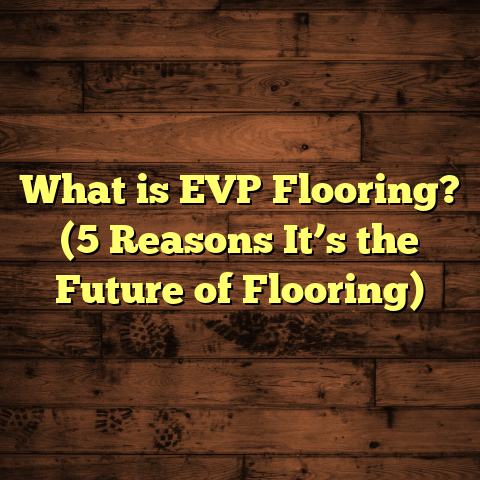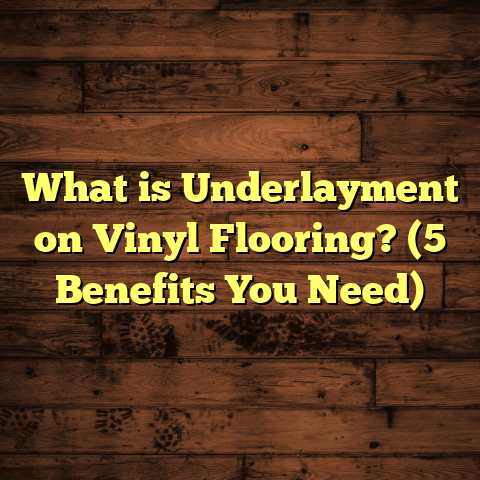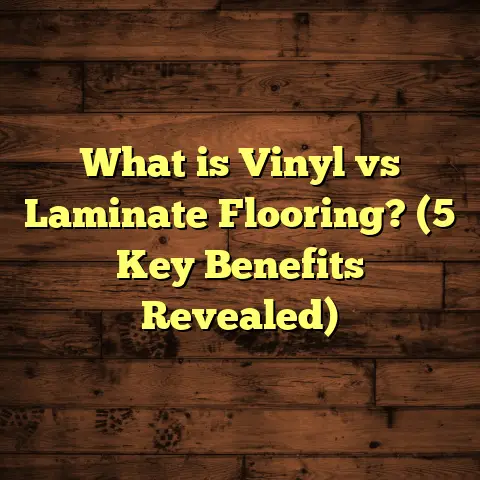What is Vinyl Tile Flooring? (5 Benefits You Didn’t Know!)
According to recent industry reports, vinyl flooring sales have grown by over 30% in the last five years alone. That’s a huge jump, and it tells me something valuable: people are really warming up to vinyl tile flooring. As someone who’s been working with all kinds of flooring materials for years, I wanted to share what makes vinyl tile flooring stand out—and maybe surprise you with five benefits you might not have heard about.
What Is Vinyl Tile Flooring?
So, what exactly is vinyl tile flooring? Simply put, vinyl tile is a type of resilient flooring made primarily from polyvinyl chloride (PVC). It’s designed to mimic other flooring types like stone, ceramic, or wood but comes with its own unique properties. Unlike traditional tiles, vinyl tiles are flexible, durable, and typically thinner, making them easier to install and maintain.
Vinyl tile comes in various forms—sheet vinyl cut into squares, luxury vinyl tiles (LVT), and even luxury vinyl planks (LVP), which look like hardwood strips. The most common type used in residential and commercial spaces is LVT because it offers a balance of aesthetics and durability.
How Is Vinyl Tile Made?
The manufacturing process is pretty interesting and plays a big role in vinyl tile’s performance. It starts with layers of PVC resin combined with plasticizers that give the material its flexibility. Then, a printed design layer is added, which gives it the look of wood grain, stone patterns, or any other texture. On top of that is a clear wear layer made from urethane or aluminum oxide, which protects the surface from scratches and stains.
Here’s a quick breakdown of the layers:
- Backing Layer: Provides stability and often includes felt or foam for comfort.
- Core Layer: The thickest part, made of PVC composite for durability.
- Design Layer: A high-definition printed film that replicates natural materials.
- Wear Layer: Transparent protective coating that guards against wear and tear.
The thickness of vinyl tiles usually ranges from 2 mm to 8 mm. Thicker tiles generally offer better sound absorption and comfort underfoot.
The Science Behind Vinyl’s Durability
One of the reasons vinyl tile flooring performs so well is due to the chemical makeup of PVC. Polyvinyl chloride is a polymer that has been modified with plasticizers to achieve flexibility. This modification ensures that the flooring can bend slightly under pressure without cracking.
Additionally, the wear layer on top is engineered to be resistant to abrasion and UV damage. Some manufacturers add microscopic ceramic beads or aluminum oxide particles into this layer, which enhances hardness without making the floor brittle.
This combination of a flexible core and a tough wear layer means vinyl tiles can endure heavy foot traffic and resist dents better than many other flooring materials.
My Personal Journey with Vinyl Tile Flooring
I’ll admit—when I first started as a flooring contractor over a decade ago, I was skeptical about vinyl tiles. I thought they were just a cheap alternative to real wood or stone. But after installing them in several homes and businesses—and seeing how well they held up—I changed my mind.
One memorable project was a small café where the owners wanted the look of hardwood without the cost or maintenance headaches. We installed luxury vinyl tiles with a beautiful oak design. Not only did the floor look stunning, but it survived heavy foot traffic and occasional spills without a single issue. Months later, they told me they were thrilled because cleaning was a breeze and the floor still looked brand new.
Another time, I worked on an office renovation where budget constraints pushed us toward vinyl tiles instead of ceramic or hardwood. I was amazed at how quickly my team installed the floor—less than two days for an entire 1,000-square-foot space—and how well it dampened noise in a usually loud environment.
These experiences made me realize vinyl tile flooring isn’t just practical; it’s smart design for real life.
5 Benefits of Vinyl Tile Flooring You Didn’t Know
1. Excellent Moisture Resistance
Did you know vinyl tiles are almost waterproof? Unlike hardwood or laminate, they don’t warp or swell when exposed to moisture. This makes them perfect for kitchens, bathrooms, basements, and even laundry rooms.
In fact, research shows that vinyl flooring can withstand water exposure for hours without damage. This property drastically reduces maintenance worries in spaces prone to spills or humidity.
In one of my recent projects—a family home with kids and pets—the kitchen floor was constantly exposed to spilled drinks and water from the dishwasher. We chose luxury vinyl tiles with an enhanced waterproof core layer. After two years, the floor still looks flawless despite all the wear and tear.
Vinyl tile’s moisture resistance also means it resists mold and mildew growth better than porous materials like wood or grout-heavy ceramic tiles.
2. Sound Absorption Properties
Here’s something many people overlook: vinyl tile can reduce noise. Because of its composition and backing options (like foam or cork underlayment), it dampens sounds better than hard surfaces like ceramic or stone tiles.
In apartment buildings or multi-level homes where noise travels easily, this becomes a huge advantage. I’ve installed vinyl floors in apartments where noise reduction was a priority. Tenants reported noticeably less footstep noise compared to traditional tile floors.
Vinyl’s ability to absorb sound comes from both its flexible core layer and optional cushioned backings that help reduce impact noise.
In fact, studies from the National Institute of Building Sciences show that floors with cushioned vinyl coverings can reduce sound transmission by up to 15 decibels compared to bare concrete slabs.
3. Versatile Design Options
Vinyl tiles come in an incredible range of designs—more than I ever expected when I started. From realistic wood grains to bold geometric patterns, manufacturers have pushed the limits of printed design technology.
For example, some brands use 3D printing techniques to create textures you can feel under your feet. This means you get authentic looks without sacrificing durability or comfort.
I’ve seen vinyl flooring that perfectly mimics exotic hardwoods like Brazilian cherry or reclaimed barn wood—something nearly impossible to replicate affordably with other materials.
What’s more, you can mix and match patterns for custom looks or use vinyl tiles for creative accents in commercial spaces like restaurants or boutiques.
Because they’re made from printed films sealed under protective layers, these designs won’t fade easily—even under intense sunlight exposure near windows.
4. Easy Installation Saves Time and Money
One thing I learned quickly: vinyl tile installation is one of the fastest among flooring types. Many vinyl tiles feature click-lock systems that snap together without glue or nails.
This speeds up projects significantly. For instance, I once completed a 500-square-foot office floor in just one day with my crew—something that would have taken twice as long with hardwood or ceramic tile.
Because vinyl tiles are lighter than stone or ceramic, handling and moving them during installation is easier on workers too—which can reduce labor fatigue and improve quality.
Some products even come with adhesive backing for peel-and-stick installation—a great option for DIYers wanting quick fixes or temporary solutions.
Fewer tools are needed as well: no need for wet saws or grout mixing like ceramic tile installations require.
5. Eco-Friendly Advances in Manufacturing
You might not realize this, but the vinyl industry has made strides toward sustainability recently. Some manufacturers now produce vinyl tiles with recycled content and low-VOC (volatile organic compounds) emissions.
My team has used these eco-friendly options on several projects where indoor air quality was a major concern—like schools and healthcare facilities. Clients were glad to find that their floors were safer for kids and staff while maintaining all the benefits of vinyl.
For example, Armstrong Flooring offers products with up to 40% recycled content and certifications like FloorScore®, which tests indoor air quality standards.
Manufacturers have also improved production efficiency by reducing energy consumption and waste during manufacturing processes.
Deep Dive: The Manufacturing Process That Makes Vinyl Tiles So Durable
Understanding how vinyl tile is made gives you insight into why it performs so well across different environments.
Raw Materials
The primary ingredient is polyvinyl chloride (PVC) resin—a synthetic plastic polymer derived mainly from salt and natural gas through polymerization.
Plasticizers such as phthalates are added to make PVC flexible rather than brittle. However, due to health concerns around certain plasticizers, many manufacturers now use non-phthalate alternatives.
Fillers like calcium carbonate improve strength while reducing production costs.
Layer Construction
The manufacturing process uses extrusion or calendaring methods:
- Extrusion involves melting raw materials together and forcing them through rollers to form sheets.
- Calendaring uses rollers to press layers into thin films with precise thickness control.
Multiple layers are bonded under heat and pressure:
- The backing layer supports stability.
- The core layer provides durability.
- The print layer uses high-resolution rotary or digital printing techniques.
- The wear layer is coated on top using UV curing processes that harden protective coatings quickly and uniformly.
Quality Control Measures
Advanced inspection technologies check thickness tolerances, color consistency, surface texture, and adhesion strength across production batches.
This attention to detail ensures every sheet or tile meets performance standards before shipment.
Case Study: Vinyl Tile Flooring in Commercial Settings
I recently worked on a large project involving an office building renovation in downtown Chicago. The client wanted durable flooring that looked professional yet was budget-conscious.
We recommended luxury vinyl tile with a commercial-grade wear layer (30 mils) designed for heavy foot traffic areas such as lobbies and conference rooms.
Here’s what happened:
- Installation took just 5 days for over 10,000 square feet.
- The floor’s sound absorption helped reduce corridor noise complaints.
- Maintenance costs dropped by over 40% compared to previous carpeted floors.
- Employees reported liking the “warmth” and “quiet” feel underfoot versus cold concrete slabs they had before.
- After one year, the floor showed minimal scratches or wear marks despite constant use.
Data from building management confirmed these subjective reports with lower cleaning expenses and longer replacement cycles projected compared to other materials previously used.
Maintenance Tips Based on My Experience
Keeping vinyl tile floors looking great isn’t difficult if you follow some simple steps:
- Sweep or vacuum regularly to remove grit that could scratch surfaces.
- Mop with warm water mixed with mild detergent designed for vinyl floors.
- Avoid abrasive cleaners or wax-based polishes—they can dull or damage the wear layer.
- Use mats at entrances to trap dirt before it reaches your floors.
- Immediately wipe spills to prevent staining.
- Consider periodic professional cleaning if your floor sees heavy use.
Following these tips helped many clients I’ve worked with keep their floors looking fresh well beyond expected lifespans.
Frequently Asked Questions I Hear When Working With Clients
Q: How long does vinyl tile flooring typically last?
A: With proper care, residential-grade vinyl tile lasts 15–20 years; commercial-grade can last up to 25 years depending on traffic levels.
Q: Can vinyl tiles be installed over existing floors?
A: Often yes—as long as the existing floor is flat, clean, and dry. Vinyl’s thin profile allows installation over concrete slabs, wood subfloors, or even old tiles sometimes.
Q: Is vinyl tile flooring safe for homes with pets?
A: Definitely! Vinyl resists scratches better than hardwoods and is easy to clean pet accidents from without damage or odor retention.
Q: How does vinyl compare cost-wise?
A: Vinyl tends to be more affordable than hardwood or ceramic tile when factoring in material plus installation costs—usually $3–$7 per square foot installed for residential projects versus $8–$12 for hardwoods.
Vinyl Tile vs Other Popular Flooring Options: My Take
I’ve installed pretty much every type of floor—from hardwoods and laminates to ceramics and carpets—so here’s how I see vinyl standing out:
| Feature | Vinyl Tile | Hardwood | Ceramic Tile | Laminate | Carpet |
|---|---|---|---|---|---|
| Durability | High (especially commercial) | High but prone to scratches | Very high but brittle | Moderate | Low |
| Moisture Resistance | Excellent | Poor | Excellent | Poor | Poor |
| Installation Ease | Very easy | Difficult | Moderate | Easy | Easy |
| Maintenance | Low | Moderate | Low | Moderate | High |
| Cost (Material + Labor) | Moderate | High | Moderate | Low | Low |
| Noise Absorption | Good | Moderate | Poor | Moderate | Excellent |
| Comfort Underfoot | Good | Good | Poor | Moderate | Excellent |
Vinyl hits a great balance between affordability, durability, style options, and ease of maintenance compared with other popular choices—making it a reliable option for many households and businesses alike.
Exploring Innovations in Vinyl Tile Flooring
The flooring industry keeps pushing innovation boundaries in vinyl technology:
- Rigid Core Vinyl Tiles (SPC/WPC) combine stone plastic composite (SPC) or wood plastic composite (WPC) cores with traditional vinyl layers for enhanced stability and waterproofing.
- Enhanced Textures: New embossing techniques create even more realistic textures that replicate natural materials closely.
- Antimicrobial Coatings: Some products now include antimicrobial agents within their wear layers—a big plus for healthcare environments.
- Smart Flooring Solutions: Integration of RFID tags within tiles helps facility managers track inventory or usage patterns in large commercial spaces.
- Recyclability Improvements: Development of fully recyclable vinyl products reduces landfill impact at end-of-life stages.
I always keep an eye on these trends because they influence what I recommend depending on client needs—from durability focus to environmental concerns.
Sharing More Stories from My Projects
I want to tell you about another interesting experience installing luxury vinyl tile in a historic home renovation project last year. The homeowners wanted authentic hardwood aesthetics but needed moisture-resistant flooring due to an old basement conversion into living space prone to dampness.
We chose waterproof luxury vinyl planks with embossed wood grain texture that replicated century-old oak beautifully. The ease of installation allowed us to complete the project ahead of schedule while preserving the home’s character visually without risking water damage issues common in basements.
The homeowners were thrilled because their new floor gave them peace of mind plus classic beauty at a fraction of hardwood restoration costs.
Environmental Impact: How Vinyl Tile Stacks Up Today
Some people worry about plastics in flooring products affecting health and environment negatively. That’s understandable; however, modern manufacturing has come far:
- VOC emissions during installation have dropped dramatically due to low-VOC adhesives and finishes.
- Many brands comply with environmental standards like GREENGUARD Gold certification.
- Recycling programs exist where old vinyl flooring can be reprocessed into new material instead of landfill dumping.
- New bio-based plasticizers reduce reliance on petrochemicals traditionally used in PVC production.
My advice? If sustainability matters to you when choosing floors, look for certified products specifying recycled content percentages and independent eco-labels.
Wrapping Up Things You Should Know About Vinyl Tile Flooring
After years working hands-on with flooring materials, I can say vinyl tile flooring offers an impressive blend of style, durability, and practicality. What surprised me most was how versatile it can be—from quiet apartments to busy cafés—and how easy it is to keep looking great year after year.
If you’re thinking about new flooring but want something that balances cost, appearance, and performance without fuss, vinyl tile deserves serious consideration.
Have you tried vinyl tile flooring yet? If not, maybe it’s time to give it a shot—you might end up loving it as much as I do!





